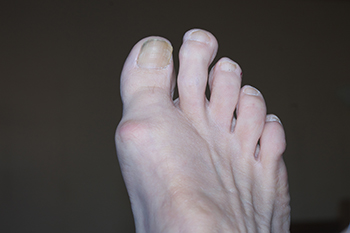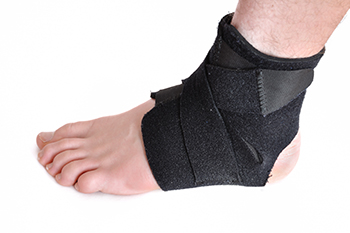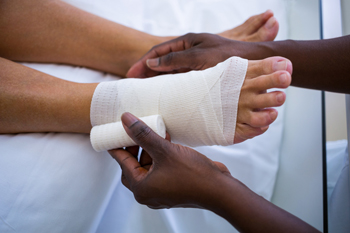Connect With Us
Blog
Items filtered by date: September 2023
Causes and Solutions for Second Toe Pain

Second toe pain can be a bothersome and discomforting issue, impacting your daily activities and quality of life. Understanding the potential causes and effective treatments is crucial for finding relief and maintaining optimal foot health. One common culprit of second toe pain is wearing improperly fitting shoes. Tight, narrow, or pointy shoes can compress the toes, leading to discomfort and deformities such as hammertoes. High heels, which force excessive weight onto the toes, can exacerbate this problem. Another frequent cause is overuse or repetitive stress, often seen in athletes or individuals engaged in activities that involve pushing off with the toes. This can lead to conditions that can include metatarsalgia or stress fractures. To address second toe pain, begin by wearing comfortable, properly fitting shoes with adequate toe room. Wearing custom orthotics can provide additional support and alleviate pressure. Rest, and taking over-the-counter pain relievers can help manage acute pain, and exercises may be beneficial for chronic issues. If second toe pain persists or worsens, it is suggested that you consult a podiatrist for a proper diagnosis and tailored treatment plan.
Toe pain can disrupt your daily activities. If you have any concerns, contact one of our podiatrists of Personal Podiatry Associates. Our doctors can provide the care you need to keep you pain-free and on your feet.
What Causes Toe Pain?
Most severe toe pain is caused due to a sports injury, trauma from dropping something heavy on the toe, or bumping into something rigid. Other problems can develop over time for various reasons.
Toe pain can be caused by one or more ailments. The most common include:
- Trauma
- Sports injury
- Wearing shoes that are too tight
- Arthritis
- Gout
- Corns and calluses
- Hammertoe
- Bunions
- Blisters
- Ingrown toenails
- Sprains
- Fractures (broken bones)
- Dislocations
When to See a Podiatrist
- Severe pain
- Persistent pain that lasts more than a week
- Signs of infection
- Continued swelling
- Pain that prevents walking
Diagnosis
In many cases the cause of toe pain is obvious, but in others, a podiatrist may want to use more advanced methods to determine the problem. These can range from simple visual inspections and sensation tests to X-rays and MRI scans. Prior medical history, family medical history, and any recent physical traumatic events will all be taken into consideration for a proper diagnosis.
Treatment
Treatments for toe pain and injuries vary and may include shoe inserts, padding, taping, medicines, injections, and in some cases, surgery. If you believe that you have broken a toe, please see a podiatrist as soon as possible.
If you have any questions please feel free to contact our offices located in Tamarac and Pembroke Pines, FL . We offer the newest diagnostic tools and technology to treat your foot and ankle needs.
Causes of Ankle Instability

Ankle instability can be a persistent and troublesome issue for many people, affecting their daily activities and overall quality of life. It often arises due to a variety of factors that compromise the stability of the ankle joint. One common cause of ankle instability is a history of ankle sprains. When an ankle is sprained, the ligaments that support it may stretch or tear, weakening its ability to hold the joint in place. Muscle weakness is another contributing factor, as insufficient strength in the muscles surrounding the ankle can increase the joint’s instability. Additionally, certain medical conditions, such as ligament laxity and joint hypermobility, can predispose individuals to ankle instability. Improper footwear choices, especially high heels or shoes lacking adequate support, can also strain the ankle joint over time. Finally, biomechanical issues like overpronation or supination can create an imbalance, which further increases the risk of ankle instability. If you're experiencing ankle instability, it is suggested that you make an appointment with a podiatrist for a personalized assessment and guidance on managing your condition.
Ankle pain can be caused by a number of problems and may be potentially serious. If you have ankle pain, consult with one of our podiatrists from Personal Podiatry Associates. Our doctors will assess your condition and provide you with quality foot and ankle treatment.
Ankle pain is any condition that causes pain in the ankle. Due to the fact that the ankle consists of tendons, muscles, bones, and ligaments, ankle pain can come from a number of different conditions.
Causes
The most common causes of ankle pain include:
- Types of arthritis (rheumatoid, osteoarthritis, and gout)
- Ankle sprains
- Broken ankles
- Achilles tendinitis
- Achilles tendon rupture
- Stress fractures
- Bursitis
- Tarsal tunnel syndrome
- Plantar fasciitis
Symptoms
Symptoms of ankle injury vary based upon the condition. Pain may include general pain and discomfort, swelling, aching, redness, bruising, burning or stabbing sensations, and/or loss of sensation.
Diagnosis
Due to the wide variety of potential causes of ankle pain, podiatrists will utilize a number of different methods to properly diagnose ankle pain. This can include asking for personal and family medical histories and of any recent injuries. Further diagnosis may include sensation tests, a physical examination, and potentially x-rays or other imaging tests.
Treatment
Just as the range of causes varies widely, so do treatments. Some more common treatments are rest, ice packs, keeping pressure off the foot, orthotics and braces, medication for inflammation and pain, and surgery.
If you have any questions, please feel free to contact our offices located in Tamarac and Pembroke Pines, FL . We offer the newest diagnostic and treatment technologies for all your foot care needs.
Rugby and Foot Injuries

In the world of rugby, players frequently grapple with the physical demands of their sport, including that associated with tackles and rapid bursts of running. These actions place immense strain on the feet and ankles, crucial for balance and propulsion in scrums or while evading tackles. Proper form is paramount, especially when deadlifting and squatting. In junior and adolescent rugby, common foot related issues include Osgood-Schlatter's and Sinding-Larsen-Johansson syndrome, which cause knee pain, as well as Sever's disease, leading to heel discomfort. Shin splints and ankle sprains are also prevalent. Senior rugby players encounter additional concerns such as forefoot pain, calf and hamstring tears, and conditions that can include plantar fasciitis and Achilles tendon pain. Preventing and treating these issues involves assessments, tailored treatments, and analyzing movement patterns. It is also beneficial to address structural problems, and incorporate strength programs and balance training. Treatments range from strapping and having footwear assessments to orthotics and advanced rehabilitation techniques. If you or your child plays rugby, and especially if either one of you has endured a foot or ankle injury, it is suggested that you make an appointment with a podiatrist for further advice and necessary treatment.
Sports related foot and ankle injuries require proper treatment before players can go back to their regular routines. For more information, contact one of our podiatrists of Personal Podiatry Associates. Our doctors can provide the care you need to keep you pain-free and on your feet.
Sports Related Foot and Ankle Injuries
Foot and ankle injuries are a common occurrence when it comes to athletes of any sport. While many athletes dismiss the initial aches and pains, the truth is that ignoring potential foot and ankle injuries can lead to serious problems. As athletes continue to place pressure and strain the area further, a mild injury can turn into something as serious as a rupture and may lead to a permanent disability. There are many factors that contribute to sports related foot and ankle injuries, which include failure to warm up properly, not providing support or wearing bad footwear. Common injuries and conditions athletes face, including:
- Plantar Fasciitis
- Plantar Fasciosis
- Achilles Tendinitis
- Achilles Tendon Rupture
- Ankle Sprains
Sports related injuries are commonly treated using the RICE method. This includes rest, applying ice to the injured area, compression and elevating the ankle. More serious sprains and injuries may require surgery, which could include arthroscopic and reconstructive surgery. Rehabilitation and therapy may also be required in order to get any recovering athlete to become fully functional again. Any unusual aches and pains an athlete sustains must be evaluated by a licensed, reputable medical professional.
If you have any questions please feel free to contact our offices located in Tamarac and Pembroke Pines, FL . We offer the newest diagnostic and treatment technologies for all your foot and ankle needs.
Foot Infections and Wounds

There are many types of foot infections and they can be from a host of causes having to do with biomechanics of the feet and underlying health conditions. Patients with foot wounds often have diabetes, peripheral vascular disease, or other metabolic conditions. However, foot infections can also result from traumatic injuries or tissue loss, leading to contamination by foreign materials and bacteria formation. Over time, treatment approaches to foot infections have evolved, influenced by advancements in pharmacology and medical technology with the goal of preserving limbs. Plastic and reconstructive procedures have revolutionized the management of certain foot infections. The primary objectives now include restoring functionality and significantly reducing the need for amputations. These developments represent a promising shift in the management of foot infections, offering hope for improved outcomes in patients facing these challenging conditions. If you have a foot infection or wound, it is suggested that you make an appointment with a podiatrist as soon as possible to determine the cause of the wound and the best way to deal with it.
Wound care is an important part in dealing with diabetes. If you have diabetes and a foot wound or would like more information about wound care for diabetics, consult with one of our podiatrists from Personal Podiatry Associates. Our doctors will assess your condition and provide you with quality foot and ankle treatment.
What Is Wound Care?
Wound care is the practice of taking proper care of a wound. This can range from the smallest to the largest of wounds. While everyone can benefit from proper wound care, it is much more important for diabetics. Diabetics often suffer from poor blood circulation which causes wounds to heal much slower than they would in a non-diabetic.
What Is the Importance of Wound Care?
While it may not seem apparent with small ulcers on the foot, for diabetics, any size ulcer can become infected. Diabetics often also suffer from neuropathy, or nerve loss. This means they might not even feel when they have an ulcer on their foot. If the wound becomes severely infected, amputation may be necessary. Therefore, it is of the upmost importance to properly care for any and all foot wounds.
How to Care for Wounds
The best way to care for foot wounds is to prevent them. For diabetics, this means daily inspections of the feet for any signs of abnormalities or ulcers. It is also recommended to see a podiatrist several times a year for a foot inspection. If you do have an ulcer, run the wound under water to clear dirt from the wound; then apply antibiotic ointment to the wound and cover with a bandage. Bandages should be changed daily and keeping pressure off the wound is smart. It is advised to see a podiatrist, who can keep an eye on it.
If you have any questions, please feel free to contact our offices located in Tamarac and Pembroke Pines, FL . We offer the newest diagnostic and treatment technologies for all your foot care needs.

